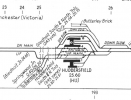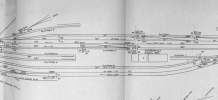In most stations the main buildings are close to platform 1, or the lowest numbered through platform if there are bays on that side. This may be because that is the "up" side where trains to the nearest large city / junction with the main line depart from, and therefore the one from which most passengers are travelling from, as they need more facilities - waiting rooms, ticket issuing,etc - the opposite platform needs much less in the way of facilities as most passengers are alighting, and just want to leave the station as soon as possible. Some stations are the other way round though, with the main buildings and platform1 on the down side, often because the approach from the town centre is on that side (e.g Newark Northgate)
Lincoln is an interesting example as when it was built in the 1840s the route to London was to the east, via Boston, main buildings and lowest numbered platforms were on the north side of the station. (There were four bays on that side so the main through platform was No5 - now No 3).The direct line to Grantham provided a more direct route to London, but also left to the east. That line closed in 1966 and London services were diverted to St Marks station via Newark, until that too closed in 1985, when London trains returned to Central, but now running to and from the west end of the station. Thus the main direction not only for London but services to Nottingham and Sheffield now all leave to the west. But despite a resignalling and renumbering, the platforms are still numbered from north to soiuth
Kingston is an interesting exception. It opened as a terminus, with trains running via Twickenham to London.Although the line was extended to New Malden very soon afterwards, the line originally dived under the SWML (you can still see the twin underpasses, although only one is used now) and ran alongside it to Wimbledon, where trains continued via Tooting to join the LCDR (now Thameslink) route to Ludgate Hill.
So although Kingston was now a through station, the main London-bound platform was still seen as that via Twickenham. Even when the station was rebuilt in the 1930s the main buildings (waiting room, toilets, staff room) were on the Twickenham bound side, where they remain to this day, leaving the majority of Waterloo-bound passengers (via Wimbledon), waiting on Platform 3 with minimal waiting facilities and staff presence, and no toilets.


